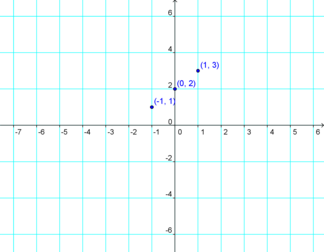Mathematical (Linear) relationships
We are going to start by looking at simple functions called linear equations. When none of the instances of x and y in the algebraic expression defining the function rule have exponents then all the instances of x and y can be combined into just two occurrences. The graph of the expression can be represented as a straight line. The equation that expresses the function is considered a linear equation with two variables. The following equation is a simple example of such a linear equation:
Since y is the dependent variable it is standing in for the function. We can re-write the expression as f(x) - x = 2. If we add an x to both sides the equality property holds and we get the expression f(x) - x + x = x + 2. Simplifying we get f(x) = x + 2. In the following table we'll pick 3 values for x, and then calculate the dependent (y) values from f(x).
| x value | y value (abscissa) | Coordinates (x,y) |
|---|---|---|
| -1 | 1 | (-1,1) |
| 0 | 2 | (0,2) |
| 1 | 3 | (1,3) |
where x and y are variables to be plotted in a two-dimensional Cartesian coordinate graph as shown here:
This function is equivalent to the previous example of a linear equation, y - x = 2. The arrows at each end of the line indicate that the line extends infinitely in both directions. All linear functions of a single input variable have or can be algebraically arranged to have the general form:
where x and y are variables, f(x) is the function of x, m is a constant called the slope of the line, and b is a constant which is the ordinate of the y-intercept (i. e. the value of y where the function line crosses the y-axis). The slope indicates the steepness of the line. In the previous example where y = x + 2, the slope m = 1 and the y-intercept ordinate b = 2. The y = mx+b form of a linear function is called the slope-intercept form.
Unless a domain for x is otherwise stated, the domain for linear functions will be assumed to be all real numbers and so the lines in graphs of all linear functions extend infinitely in both directions. Also in linear functions with all real number domains, the range of a linear function will cover the entire set of real numbers for y, unless the slope m = 0 and the function equals a constant. In such cases, the range is simply the constant.
Conversely, if a function has the general form y = mx + b or if it can be arranged to have that form, the function is linear. A linear equation with two variables has or can be algebraically rearranged to have the general form1:
where x and y represent the linear variables, and the letters A, B, and C can represent any real constants, either positive or negative. Conversely, an equation with two variables x and y having that general form, or being able to be arranged in that form, would be linear as long as A and B are not both equal to 0. In the preceding equation, capital letters are to avoid confusion with other constants in this chapter and for consistency with Reference 1.
If one divides the preceding equation by B (when B is not 0) and solves for y, the following form can be obtained:
If one equates -A/B to the slope m and C/B to the y-intercept ordinate b, it can be seen that the general form for a linear equation and the slope-intercept form for a linear function are practically interconvertible except for the fact that, in a linear function, the B constant in the linear equation form cannot equal 0.
General Equation Forms of a Line
The most general form applicable to all lines on a two-dimensional Cartesian graph is
with three constants, A, B, and C. These constants are not unique to the line because multiplying the whole equation by a constant factor gives a new set of valid constants for the same line. When B = 0, the rest of the equation represents a vertical line, which is not a function. If B ≠ 0, then the line is a function. Such a linear function can be represented by the slope-intercept form which has two constants.
Slope-intercept form:
The two constants, m and b, used together are unique to the line. In other words, a certain line can have only one pair of values for m and b in this form.
The point-slope form given here
uses three constants; m is unique for a given line; x1 and y1 are not unique and can be from any point on the line. The point-slope cannot represent a vertical line.
The intercept form of a line, given here,
uses two unique constants which are the x and y intercepts, but cannot be made to represent horizontal or vertical lines or lines crossing through (0,0). It is the least applicable of the general forms in this summary.
Of the last three general forms of a linear function, the slope-intercept form is the most useful because it uses only constants unique to a given line and can represent any linear function. All of the problems in this book and in mathematics in general can be solved without using the point-slope form or the intercept form unless they are specifically called for in a problem. Generally, problems involving linear functions can be solved using the slope-intercept form
(y = m x + b) and the formula for slope.
Licensing
Content obtained and/or adapted from:
- Linear Equations and Functions, Wikibooks under a CC BY-SA license
- Function Graphing, Wikibooks under a CC BY-SA license








